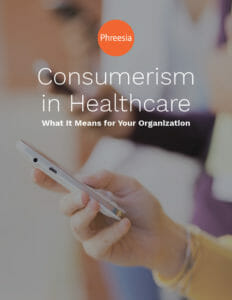What is Healthcare Consumerism?
As out-of-pocket healthcare costs continue to grow, patients are increasingly looking for providers who offer the convenience, personalization and customer service they’re used to experiencing in retail and other industries. These healthcare consumerism trends are reshaping the healthcare industry, and that means medical practices and health systems should act now to meet patients’ changing expectations.
To find out how, download our new white paper “Consumerism in Healthcare—What It Means for Your Organization,” to learn:
• Best practices for improving customer service
• Tips for engaging patients in their care
• Strategies for boosting patient loyalty and retention
Click below to download the white paper.
Healthcare Consumerism
What It Means for Your Organization
April 2018
AN INTRODUCTION TO HEALTHCARE CONSUMERISM
There are few buzzwords more ubiquitous in healthcare today than consumerism. As patients bear an ever-growing share of their healthcare costs, their preferences and expectations are evolving. Those expectations are heavily influenced by the consumer-centric features—convenience, personalization, transparency, high-quality service—they’re accustomed to experiencing in retail, banking and other industries.
Although the healthcare consumerism trend isn’t new, it’s gained tremendous momentum in recent years as patient financial responsibility has increased.
What is Driving Consumerism in Healthcare?
In 2006, the average deductible for a worker with employer-provided health insurance was $303. By 2017, that amount had ballooned nearly 400% to $1,505.1 According to the U.S. Centers for Disease Control and Prevention’s National Center for Health Statistics, more than 42% of Americans under age 65 with private insurance were enrolled in high-deductible health plans—defined as plans with deductibles of at least $1,300 for an individual and at least $2,600 for a family—during the first three months of 2017, up from 25% in 2010.2
The numbers are even more striking in the individual market. On the Affordable Care Act’s Marketplace, 90% of health plans have a high deductible.3
With more dollars at stake, patients are shopping around for the best value, playing a much more active role in their care, and seeking out their ideal experience.
For many healthcare organizations, this shift in patient expectations can seem overwhelming. At a time when they are under unprecedented pressure to improve clinical quality, control costs, adapt to new reimbursement models and manage the health of their patient population, focusing on consumerism might feel like one more in an already daunting list of competing priorities.
In reality, however, all of those goals are inextricably linked. Making your organization more consumer-centric helps engage patients in their care, which in turn helps improve clinical outcomes. Enhancing the care experience increases patient satisfaction and retention, and ideally, boosts performance in value-based care arrangements.
In a 2016 report, the Healthcare Financial Management Association cautioned, “Health plans and providers that fail to respond to the imperatives of consumerism will risk losing relevance as the move to value-based payment gains traction, while consumer-savvy organizations will have an opportunity to gain market share. Thus, developing a consumerism strategy should be viewed not as another bullet point on a healthcare executive’s overcrowded to-do list but as a tactic that supports the paradigm shift to value-based care delivery.”4
Healthcare organizations that seize the opportunity to better understand their patients and align themselves with their preferences and needs will have an enormous advantage in a rapidly evolving system.
About This White Paper
Phreesia has authored this white paper to provide an overview of the consumer-centric trends reshaping healthcare delivery, and to share best practices and strategies that healthcare organizations can employ to improve the patient experience, engage patients in their care, and boost loyalty and retention. Although there is no one “right” way to become a consumer-driven practice, the steps outlined in this white paper are widely applicable, and will go a long way toward positioning providers for success.
PUT THE PATIENT EXPERIENCE FIRST
What does the ideal patient experience look like? Does it include walk-in visits? Online appointment scheduling? A big parking lot? Wellness education? The first step in making your organization more consumer-oriented is taking the time to understand what your patients want and expect, and then implement those features.
That seems like a logical move, but according to a recent survey of healthcare organizations, it rarely happens. Less than 10% of surveyed organizations said they treat consumer expectations as a high priority and that their organization consistently built and used consumer-centric capabilities.5
Many organizations equate being more consumer-oriented with making a simple change or two, such as setting up a patient portal, experts say. But a full commitment to consumerism in healthcare requires a culture shift throughout an organization, creating a culture that puts patients at the center of care, prioritizing their needs in every decision.6
Focus on Customer Service
There is broad consensus that a key component of the patient experience is the service patients receive when they seek care. In a 2016 study in the Journal of Medical Practice Management, researchers found that a whopping 96% of patients’ online complaints about their physicians related to customer-service issues, such as long wait times and inattentive front-desk staff.7
The good news is there are many effective solutions for improving customer service, including streamlining inefficient processes and looking for ways to deliver more convenience. For instance, if long telephone hold times are an issue, online scheduling can help. Or, if staff are harried and disorganized, consider automating some of the tasks of intake to give them more time to focus on patients.
Patient surveys provide invaluable first-hand data about where to begin making improvements. They can also fill in important gaps in understanding. While issues like waiting-room bottlenecks are easy to spot, other problems can easily go undetected if patients don’t have a platform to share them. The key is to make sure your organization uses patient survey data to inform timely change.
Provide the Technology-Enabled Experience Patients Want
One aspect of consumerism that seems to make some healthcare organizations apprehensive is the focus on digital capabilities. A common worry is that patients—particularly older ones—will be slow to embrace new technologies. But experts say those concerns are unwarranted.
In an article from consulting firm McKinsey & Company, the authors called the notion that only young people use technology to manage their health and healthcare needs “one of the most common myths about healthcare consumerism.”8 While millennials were most likely to schedule an appointment online, check their health information or text with their provider, a significant and growing number of adults over age 65 enthusiastically embrace technology when given the opportunity.
In fact, in a 2017 report on enabling healthcare consumerism, McKinsey & Company touted the growing popularity of digital solutions. “One way to increase consumers’ convenience is to provide effective digital healthcare tools. In our [Consumer Health Insights] survey, an overwhelming majority of respondents made it clear that they want digital solutions at each step in their healthcare journey.”9
Offer Flexible Payment Options
As patients assume greater responsibility for the costs of their care, they’re often looking for convenient, consumer-friendly payment options that meet their needs and help them manage their finances, including automated payment plans, online payments and the ability to put a card on file.
Such options are especially meaningful to patients on tight budgets. According to the Kaiser Family Foundation, 43% of insured adults say they have trouble affording their deductible. More than 1 in 4 report delaying or skipping care to save money.10 As a growing percentage of patients struggle to afford rising healthcare costs, flexible payment choices help position your organization as an ally and a resource.
Increase Accessibility
In survey after survey, patients consistently list convenient access to care as one of their top priorities. There are many ways to meet this expectation, including by offering extended hours, same-day and walk-in appointments, virtual visits and online appointment scheduling.
ENGAGE PATIENTS IN THEIR CARE
Increasingly, patients want to take a far more active role their own care. It’s a marked shift from the longstanding paradigm of the doctor as the decision-maker and the patient’s as the passive recipient of care. According to experts, that shift is great news, especially as the U.S. healthcare system transitions toward value-based care. Forward-looking healthcare organizations know that engaged patients are more open to changing their behaviors and are often more proactive about managing their health.
How can organizations foster greater patient engagement?
- Empower patients to identify those health goals that matter most to them and help them achieve them. For instance, a diabetes patient might be far more motivated to track her daily blood sugar because she wants to stay well enough to go to church every week, rather than tracking it simply because she’s been instructed to do so.
- Provide guidance about covered services that patients might not be aware of, and explain why those services are important. For instance, in one survey of patients in high-deductible health plans, fewer than 1 in 5 understood that many preventive visits, tests and screenings were offered free of charge under their plan. The same percentage of respondents said they had delayed preventive care in the past because of fear of cost.11
- Leverage technology, such as mobile communications, to provide a more consumer-centric experience and engage patients before, during and after their care.
- Emphasize the importance of shared decision-making, and give patients the information they need to participate in treatment conversations with their provider.
PRESENT YOUR ORGANIZATION AS TRUSTED PARTNER
One of central themes of healthcare consumerism is having access to the right data to make informed, value-driven decisions. For example, many consumers wouldn’t even consider trying a new restaurant before reading online reviews or buying a camera without researching owner feedback.
While there is far more healthcare data available now than there was even a few years ago—including clinical quality measures, cost data and facility ratings—much of it is hard for patients to understand and use. That gives your organization a great opportunity to partner with your patients and proactively steer them to helpful information.
Consider Price Transparency
It’s difficult, if not impossible, for consumers to make informed decisions about healthcare value without access to reliable data about the costs of health services. That information is even more crucial for patients with high deductibles and large out-of-pocket costs—but finding that data is no easy task.
The widespread lack of data means that providers who are forthcoming about their prices, cost estimates and other financial information will likely be viewed in a positive light by consumers. It’s also important to pair that data with frank discussions with patients about cost, particularly to understand whether they are at risk of delaying care.
Manage Your Online Reputation
Consumers do their research. If your healthcare organization has bad online reviews, there’s little doubt that prospective—and in some cases, current—patients are seeing them. Since so much of available healthcare data is confusing or hard to access, make sure the information you can control or influence is as good as it can be. Monitor your social media channels and online ratings site for negative feedback and address it, if appropriate. Encourage long-time patients to submit positive reviews.
Look for Ways to Boost Patient Loyalty and Retention
Patients are more willing than ever to try new providers, particularly if they think their experience will be more convenient or engaging. In one survey, 29% of patients said they did not have a preferred primary care provider and 45% said they had no preferred specialists.12
Given those statistics, it’s imperative that healthcare organizations look for ways to build patient loyalty. One way to do that is by adding ancillary services, such as nutrition and wellness counseling or an in-house pharmacy. Having multiple services in one location provides the “one-stop shop” experience many patients want.
Not surprisingly, trust and a positive experience are the biggest drivers of patient retention and loyalty.13 What’s the takeaway? As your patients feel increasingly empowered to shop around for the best healthcare experience, you must continually strive to ensure they are already receiving it from your organization.
CONCLUSION
Given the rapid increase in patients’ financial responsibility and their changing expectations for their healthcare, now is the time to implement processes that put patients at the center and give them the information and support they need to be empowered consumers. Healthcare organizations that proactively meet the demands of consumerism head on will be positioned for success in a shifting landscape.
ABOUT PHREESIA
Phreesia gives healthcare organizations a suite of applications to manage the patient intake process. Our innovative SaaS platform engages patients in their healthcare and provides a modern, consistent experience, while enabling healthcare organizations to optimize their staffing and enhance clinical care. Learn more at phreesia.com.
Sources:
- “2017 Employer Health Benefits Survey,” Kaiser Family Foundation/Health Research & Educational Trust, Sept. 19, 2017. http://kff.org/health-costs/report/2017-employer-health-benefits-survey/
- “Health Insurance Coverage: Early Release of Estimates from the National Health Interview Survey, January – March 2017,” National Center for Health Statistics. https://www.cdc.gov/nchs/data/nhis/earlyrelease/insur201708.pdf
- “Health Policy Brief: High-Deductible Health Plans,” Health Affairs, Feb. 4, 2016. http://healthaffairs.org/healthpolicybriefs/brief_pdfs/healthpolicybrief_152.pdf
- Health Care 2020, Report 2 of 4: Consumerism, Healthcare Financial Management Association, 2016. https://www.hfma.org/healthcare2020/
- “2017 State of Consumerism in Healthcare: Slow Progress in Fast Times,” Kaufman Hall. https://www.kaufmanhall.com/sites/default/files/2017-State-of-Consumerism-in-Healthcare.pdf
- “The Dawn of Consumerism: Key trends and strategies for healthcare consumerism” Healthcare Informatics, 2017. https://www.healthcare-informatics.com/article/dawn-consumerism-key-trendsand-strategies-healthcare-consumerism
- “Hard Internet Truths: 34,748 Online Reviews Reveal What Patients Really Want From Doctors,” Journal of Medical Practice Management, Mar-Apr 2016. https://globenewswire.com/newsrelease/2016/04/26/832480/0/en/Study-96-Percent-of-Online-Complaints-About-Doctors-Fault-Customer-Service-Not-Quality-of-Care.html
- “Debunking common myths about healthcare consumerism,” McKinsey & Company, December 2015. https://www.mckinsey.com/industries/healthcare-systems-and-services/our-insights/debunkingcommon-myths-about-healthcare-consumerism#0
- “Enabling healthcare consumerism,” McKinsey & Company, May 2017. https://healthcare.mckinsey.com/enabling-healthcare-consumerism
- “Data Note: Americans’ Challenges with Health Care Costs,” Kaiser Family Foundation, 2017. https://www.kff.org/health-costs/poll-finding/data-note-americans-challenges-with-health-care-costs/
- “In Consumer-Directed Health Plans, A Majority Of Patients Were Unaware Of Free Or Low-Cost Preventive Care,” Health Affairs, Dec. 2012. https://www.healthaffairs.org/doi/full/10.1377/hlthaff.2012.0059
- “Enabling healthcare consumerism,” McKinsey & Company, May 2017. https://healthcare.mckinsey.com/enabling-healthcare-consumerism
- “The birth of the healthcare consumer: Growing demands for choice, engagement, and experience,” Strategy&, 2014. https://www.strategyand.pwc.com/media/file/The-birth-of-the-healthcare-consumer.pdf
Learn how Phreesia provides flexible, consumer-centric patient payment options.






